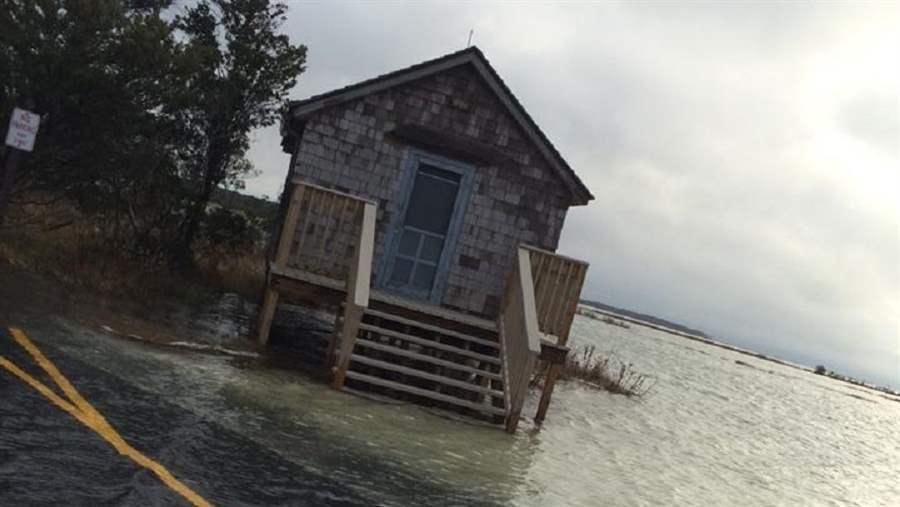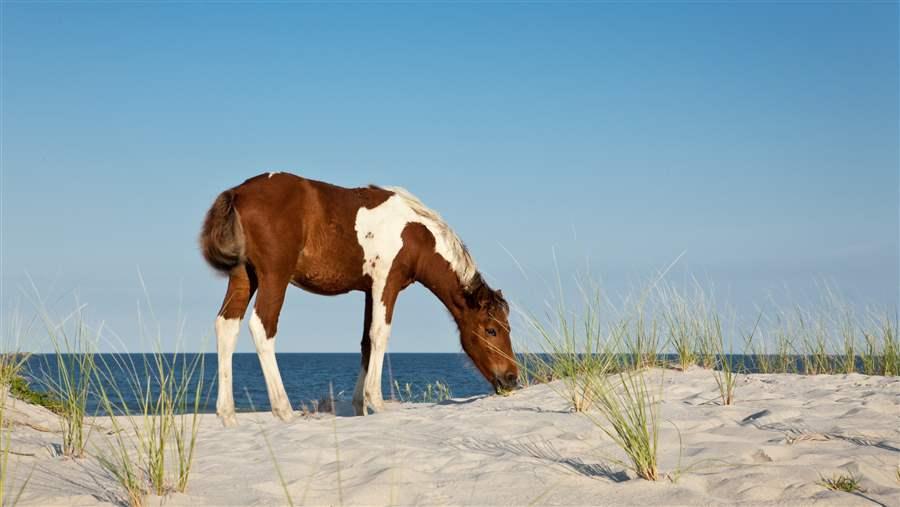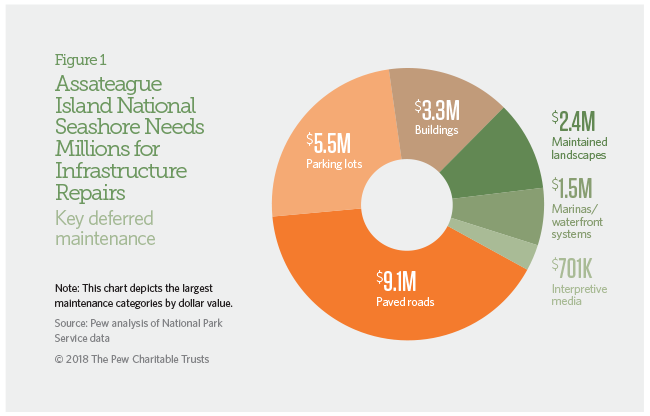Assateague Island National Seashore
Maryland and Virginia
Pew created this case study using National Park Service deferred maintenance data issued in fiscal year 2015. The information listed here may no longer reflect the NPS site’s current condition or maintenance requirements. To find the most up-to-date information, please use the National Park Repair Needs tool.
Overview
Visitors to Assateague Island National Seashore see firsthand the balance between preservation and recreation. The island’s sandy beaches, salt marshes, and coastal bays provide important habitat for its popular wild horses, white-tailed deer, and waterfowl, as well as blue crabs, Atlantic menhaden, and summer flounder. Conservation of these species is carefully balanced with access to horseback riding, hunting, hiking, fishing, and camping.
Unfortunately, Assateague has a backlog of millions of dollars in infrastructure repairs that is detracting from visitors’ experiences and harming the local ecosystem.

Coastal storms wash over roads and parking lots at Old Ferry Landing and elsewhere in the park, damaging buildings and roadways.
© Assateague Coastal Trust
Maintenance challenges
Assateague Island is a barrier island whose landscape is continually reshaped by ocean currents and storms. Severe storms, such as Hurricane Sandy in 2012 and winter storm Jonas in 2016, have washed out roads, inundated parking lots, and destroyed boardwalks. In addition to the weather pressures, the more than 2.2 million visitors each year have caused roads to deteriorate and parking facilities to overflow. As of October 2015, road repairs—including resurfacing Bayside Drive—represented the biggest slice of deferred maintenance, at over $9 million. Another $5.5 million is needed to fix parking lots on the oceanfront and around visitor centers.
Once visitors leave their cars, other needed repairs become apparent. Visitor centers and visitor contact stations, campgrounds, entrance booths, and bike trails all require maintenance. The Barrier Island Visitor Center needs over a quarter of a million dollars in repairs, and the seashore administration building needs $744,000 worth of fixes. Entrance booths, campground offices, and restroom/shower houses at North and South Ocean Beach require close to $100,000 in restoration. Additional work is needed at a wastewater treatment center, a generator building, a maintenance shop, district ranger stations, and boat sheds, totaling almost half a million dollars. Deferred maintenance costs for buildings and structures throughout the park are $3.3 million.
But Assateague Island’s largest maintenance needs involve its roads, parking lots, and trails. This barrier island has ocean on two sides, making it extremely vulnerable to coastal storms that frequently flood parts of it, causing erosion and sand deposition. Road repairs, especially to Oceanside and Bayside drives, amount to $9.1 million. Upkeep for parking lots, including those at North and South Ocean Beach, Bayside Picnic and Parking Area, and Old Ferry Landing, will cost $5.5 million. And repairing biking and walking trails requires almost $1 million.
The increasing number of people who visit Assateague every year is testimony to its economic significance. In fact, I can’t think of a local Ocean City tourism-related business that doesn’t use Assateague in its advertising. But badly needed maintenance repairs, left unfunded, could hurt visitation to the seashore and affect local businesses.Dave Wilson, principal, Conservation Community Consulting
Recommendations
To address the deferred maintenance needs at Assateague and other National Park Service (NPS) sites in Maryland, Virginia, and across the country, Congress should:
- Ensure that infrastructure initiatives include provisions to address park maintenance.
- Provide dedicated annual federal funding for national park repairs.
- Enact innovative policy reforms to ensure that deferred maintenance does not escalate.
- Provide more highway funding for NPS maintenance needs.
- Create more opportunities for public-private collaboration and donations to help restore park infrastructure.
Assateague Island National Seashore Facts
2016
| Visitor spending | $98.3 million |
| Jobs created by visitor spending | 1,332 |
| Economic output | $112.2 million |
| Labor income | $38.8 million |
| Visits | 2,267,822 |
| Deferred maintenance (fiscal year 2015) | $24.5 million |
National Park Service, “Visitor Spending Effects,” accessed Oct. 6, 2017, https://www.nps.gov/subjects/socialscience/vse.htm; National Park Service, “NPS Deferred Maintenance Reports,” accessed Oct. 6, 2017, https://www.nps.gov/subjects/plandesignconstruct/defermain.htm.
© 2018 The Pew Charitable Trusts
The Pew Charitable Trusts works alongside the National Parks Conservation Association, the National Trust for Historic Preservation, and other national and local groups to ensure that our national park resources are maintained and protected for future generations to enjoy.















